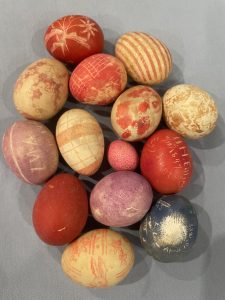
Easter eggs from the 1880s were recently found at the Botetourt Museum. They were donated by Harriett Huldah Fillinger (1890-1970). She was a professor of chemistry and head of the chemistry department at Hollins College (1921-1956) and a generous benefactor.
The process of dyeing eggs originated in the mid-1800s among the Pennsylvania Germans. They began the tradition of presenting children gaily colored eggs at Easter. These eggs were hard boiled and dyed with dried onion skins and other natural ingredients.
“H H Fillinger 4/18/1897 Egg Hunt” can be seen on the red egg. “Ina Lee April 10 1887” can be seen on the blue egg. The darkly colored eggs were “scratch-carved” by using a sharp knife to expose the white shell of the egg. Other designs were created by wrapping fabric around the egg while it was cooked. A hard tallow candle could also be used to draw on eggs and the dye would not penetrate it.
These eggs have been preserved for 120+ years and are on display for the enjoyment of others at the Botetourt Museum of History & Culture in Fincastle.
~ Botetourt County Museum of History & Culture



